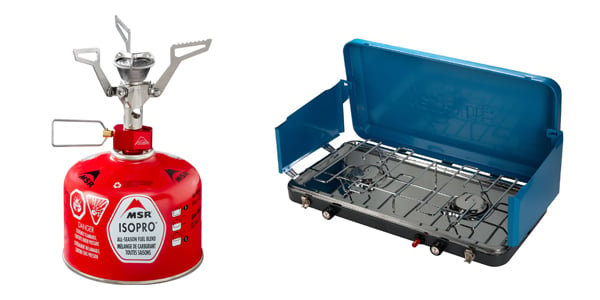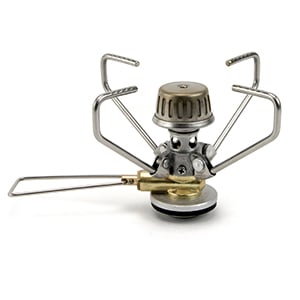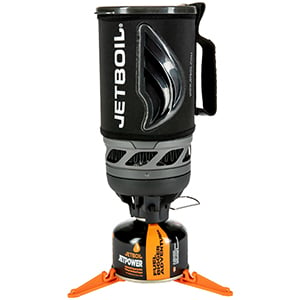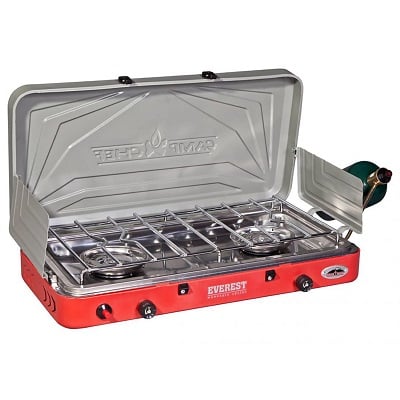How to Choose a Camp Stove - Backpacking & Car Camping
A good camp stove is essential to enjoying your outdoor adventures, letting you cook up meals to match the natural beauty you’ll encounter along the way. They’re also good for your tailgate parties, and any number of other situations. There are a whole plethora of stove options, from minimalist backpacking stoves to fully built out freestanding units that nearly rival a commercial kitchen for burner space. With the explosion of stove options, it requires a little more effort to figure out what style of camp stove you actually want, and what features you need. That’s why we’ve put together this guide to choosing a camp stove. So whether you’re trying to set a Fastest Known Time on some trail system, or you just want to drive into the woods and camp for all your friends, we’ll help you figure out how to choose a camping stove.
What are BTUs and How Do They Affect Camp Stoves
When we’re talking about camping stoves, one of the most important specs to look out for is “BTUs” BTUs, or British Thermal Units, are how the heat output from a stove is measured, the higher that number, the faster it can heat things up. For multi-burner stoves, the manufacturer will often list the BTUs for each burner separately.
Types of Camping Stoves - Backpacking vs Car Camping Stoves
Before you even start shopping for a camp stove, you need to ask yourself: “Am I ever going to want to carry this stove in my backpack?” There are two main types of camp stoves: backpacking stoves that are small and light enough to pack away in an overnight pack, and base camp or car camping stoves that are only meant to be carried a short distance from your car to your campsite. It’s nearly impossible to find a stove that is a true crossover, and sure, you can use a backpacking stove at your basecamp, but you’re definitely not going to want to pack your classic two-burner miles into the backcountry.

Backpacking stoves are very small and light, they’re often about the size of a water bottle, including the pot to boil water in. That makes them very portable, but they don’t put out much heat, and it’s hard to regulate that heat. This means they’re best used for boiling water for coffee and dehydrated meals, or oatmeal. You’re not so much “cooking” on a backpacking stove, as you’re just trying to get water to boil as fast as possible - you’re not going to be able to gently saute or simmer that backcountry Coq Au Vin. So, if you’re not spending your nights deep in the backcountry, and want a stove to cook for multiple people on, a backpacking stove won’t work well for you, and you should be looking at a larger basecamp stove.
Basecamp stoves are stoves designed to be used while car camping. They’re much bigger and are better suited to cheffing up some backcountry gourmet. These stoves elicit images of the near ubiquitous forest green two burner stove that many folks grew up with. They’re portable enough that you will have no problem carrying them a few hundred yards to the campsite, but they weigh more than many ultralight backpackers whole packs. They’re closer to a backyard grill, or a gas range than a backpacking stove. Many of these stoves have multiple burners, and it’s easier to regulate heat. This means you’re about to do things like simmer and saute, rather than just boiling. You also have the heating capacity to make a lot more food for a lot more people. For most people car camping, a basecamp stove is the way to go.
So look at the types of camping trips you like to do, are they mostly multi day epics deep in the backcountry, or do you like to just go relax in nature closer to your car. If you’re somewhere in the middle, we’d recommend looking for an affordable backpacking stove, and a cheaper basecamp stove as well. Sure, you can make a backpacking stove work while car camping, but you’re going to be severely restricted in what you can cook.
How to Choose a Backpacking Stove
Backpacking stoves are designed to be light, simple, easy to use, and packable. They’re not designed for in-depth recipes and gourmet dining - though you can certainly get a little creative. Instead, their general goal is to boil water as fast as possible. To that end, many different brands have designed unique systems to help you minimize weight and maximize pack space and efficiency.

Liquid Fuel vs Canister Backpacking Stoves
There are two main types of backpacking stoves, those that burn liquid fuel, and those that burn single-use canisters. There is also a third category of ultralight alternative fuel backpacking stoves that we’ll cover below. Each type of stove has its own pros and cons.
Liquid Fuel Backpacking Stoves
Liquid fuel camp stoves have a fuel tank that you can fill with fuel that’s available just about anywhere folks like to camp. The most common fuel type for liquid stove is white gas, it’s the best camp stove fuel and is the cleanest burning. You can use alternative fuels like kerosene, and even gasoline or diesel in a pinch. Since these fuels are available everywhere, liquid fuel camp stoves are a good idea for international or remote trips where you might not be able to find canisters. The downside is that the stoves can be a little more complicated to use, you have to prime them to get them started, and they’re less compact. These are a great choice for experienced trekkers and mountaineers.
- It’s easy to find the right fuel, anywhere in the world
- Work well at high altitudes and cold temperatures
- Cheaper fuel, refillable tank
- Harder to pack
- Fuel bottles can leak
Canister Fuel Backpacking Stoves
Canister camp stoves are usually the smallest and lightest options. They use fuel from a pre-filled canister that just screws onto the stove, or connects via a remote fuel line. They’re super compact, and very easy to use. The downside is that these canisters can be hard to find in remote locations or internationally, and they’re not as environmentally friendly since they’re single-use canisters. If you’re buying your first backpacking stove, or you’re looking for maximum convenience, we recommend getting a canister stove. There are three main types of canister stoves, ultralight stoves, integrated stoves, and remote canister stoves.
- Very small and packable
- No messy liquid fuel
- Simple to use
- Can be finicky in cold weather
- Fuel not always available
- Hard to recycle fuel canisters

Ultralight stoves are the smallest and lightest, they’re just a tiny attachment that screws onto the top of the canister that you can then balance a pot on to heat. These ultralight backpacking stoves are great for weight-conscious campers.

Integrated canister stoves, like Jetboil, build the canister into the stove to create a cohesive system. This means they’re more stable, and do a better job of heating efficiently. And often the fuel, pot, and stove all nest inside each other, which makes it easy to make sure you’re not forgetting any components. For most beginner backpackers, an integrated canister stove is the most straightforward option.

Finally, remote canister stoves are like a minimalist stove, but they run a fuel line from the fuel to the burner. This means you can turn the fuel can upside down to help it flow in cold temps, and you can use a windscreen to help the stove heat more efficiently. Remote canister stoves are a great choice if you’re going to be camping in more rugged weather or during the winter.
Alternative Fuel Camp Stoves
Finally, alternative fuel stoves use fuels other than liquid or gas fuel. There are four main styles of alternative fuel stoves: wood, pellet, alcohol, and tablet stoves. These types of stoves are often used by ultralight backpackers who value weight savings above all else. They can be a bit more difficult to use than stove systems, however, some campers swear by them.
Wood burning camping stoves are designed to burn small branches and scraps of wood to heat your water and food. They burn hot and clean, but don’t boil water as fast as a canister stove, and you’ll need to be camping somewhere with plenty of twigs to burn and no fire restrictions. Plus, if it’s raining and you can’t get your twigs to light, you won’t be boiling any water.
Pellet camping stoves burn special compressed fuel pellets. They boil water very quickly, but you’ve got to make sure you’ve got plenty of the pellets, which aren’t as widely available as liquid or gas fuel, and like a twig stove, you’ve got to pay attention to fire restrictions.
Alcohol camping stoves are the smallest and lightest stove options on this list. They’re very simple, with no moving parts to break, they boil water quickly, and the alcohol they burn is readily available. That said, they do take a little bit more practice to use safely, they’re not as stable as some canister stoves, and it’s easy to spill or vaporize their fuel, leaving you without a heat source, and smelly gear. They’re great for more experienced hikers, but for folks just starting out they’re not the best option.
Tablet camping stoves burn special fuel tablets, half ounce cubes that burn very hot and fast. Like alcohol stoves, tablet stoves are very light and packable, and affordable. The tablets are readily available at most camping stores, and you can boil water very quickly with a tablet stove. The downside is that the tablets have a weird smell that some people really don’t like, and it’s hard to control a tablet stove, they have one setting: hot. Tablet stoves are another great option for experienced hikers, but for beginners there are much better choices.
Basecamp or Car Camping Stoves
When choosing a car camping stove, you have a ton of options, from simple two-burner units to near restaurant quality burners. As with most camping gear, you’ll choose based on the way you like to camp and what your typical campsite is like. Most basecamp size stoves run off propane, either smaller, green camping canisters, or the bigger canisters that home grills run off of. Some models have adaptability between fuel sources, too. When shopping for a car camping stove, you should be looking at three basic factors: whether you need a freestanding unit, or you’ll have a table to cook on, the number and size of burners, and how many BTUs they put out per burner.
Tabletop vs Freestanding Camping Stoves
There are two main types of basecamp stoves: tabletop camping stoves that are smaller and lighter, and designed to be used on a picnic or camping table, and freestanding units that are more similar to a home grill. If you’re primarily camping at established sites, with tables, a tabletop stove is fine, but freestanding options free up tablespace for prep work and eating, or let you cook in areas that don’t have tables. Another option is just to bring a light folding table for your tabletop stove so that you have the flexibility to use it anywhere. Freestanding are often equipped with larger burners, while tabletop units are still somewhat compact.

Camp Stove Burners and BTU
For most people, a two burner stove that puts out around 10,000 BTU’s per burner is a good place to start. This allows you to boil water for coffee quickly, while you cook breakfast on the other burner. A stove this size usually maxes out when you’re cooking for four people or more. There’s just not enough space or heat to make more food. So think about your typical group size. If you’re just cooking for your family, a small stove may be just fine. But if you have a big friend group that likes to all camp together, you might want to consider bumping up to a three or four burner stove. Just remember, with a basecamp stove, it’s impossible to have “too much” stove. So even if you don’t think you need that many burners, it’s not a bad idea to start out with a bigger stove and grow into it.
Camp Stove Cooking Area, Burner Size & Type
Not all burners are created equal. We’ve already discussed the BTU output of different stoves, but it’s important to take the physical size of the burner and the stove into account, too. A smaller stove, and smaller burners means that you can only use smaller cookware - you won’t be able to heat up a 12” cast iron pan on a tiny burner. Most stoves will have their cooking area listed as a spec that you can use to reference and compare. Some camping stoves also offer combinations of traditional burners and a grill or griddle. These are great for tailgating and camping alike.
Firepits & Firepit Camp Stoves
There’s no substitute for a good campfire, and cooking over open flames can be an awesome experience. While it’s fun to roast weenies on a stick, or cook tinfoil-pouch meals on the fire, there are a few accessories that can really up-level your campfire cooking.
For folks who are camping somewhere that has an established fire pit and want to cook over the fire, a camping grate is the perfect accessory. Even if your fire pit already has a grate to rest food on, you’re better off using your own. Those campground grates don’t get cleaned very often, and sometimes people burn trash on them. You don’t want anything that’s going into your mouth to touch one of those grates. So travel with your own, that you trust, and know is clean.

If you’re camping somewhere without an established fire pit, a portable fire pit system makes sense. These are very similar to backyard fire pits, they’re just designed to for travel, and are optimized for cooking. A folding fire pit system allows you to create a self-contained system to cook over an open fire. You’ll just need wood or barbecue coals as fuel. They’re a great way to safely have a fire in areas without a fire ring, just make sure to pack it carefully on your way home, you don’t want ash and soot getting all over your gear.
Learn More With Our Other Camping Guides:
- Camping - What to Bring Camping & Checklist
- Sleeping Bags - How to Choose a Sleeping Bag
- Sleeping Bags - How to Wash a Sleeping Bag
- Tents - How to Choose a Tent for Camping
- Stoves - How to Choose a Camping Stove
- Sleeping Pads - How to Choose a Sleeping Pad
- What to Pack for a Day Hike
Learn About Some of Our Favorite Gear:
- The Best Sleeping Bags
- The Best Sleeping Pads
- The Best Camping Tents
- The Best Backpacking Tents
- The Best Camping Stoves
- The Best Camping Hammocks
- The Best Camping Coffee Makers
- The Best Camping Chairs
- The Best Camping Water Filters & Water Purifiers
- The Best Camping Coolers
- The Best Camping Accessories
- The Best Camping Cookware
- The Best Headlamps & Camping Lights
- The Best Headlamps Camping Blankets
- The Best Daypacks
- The Best Duffel Bags